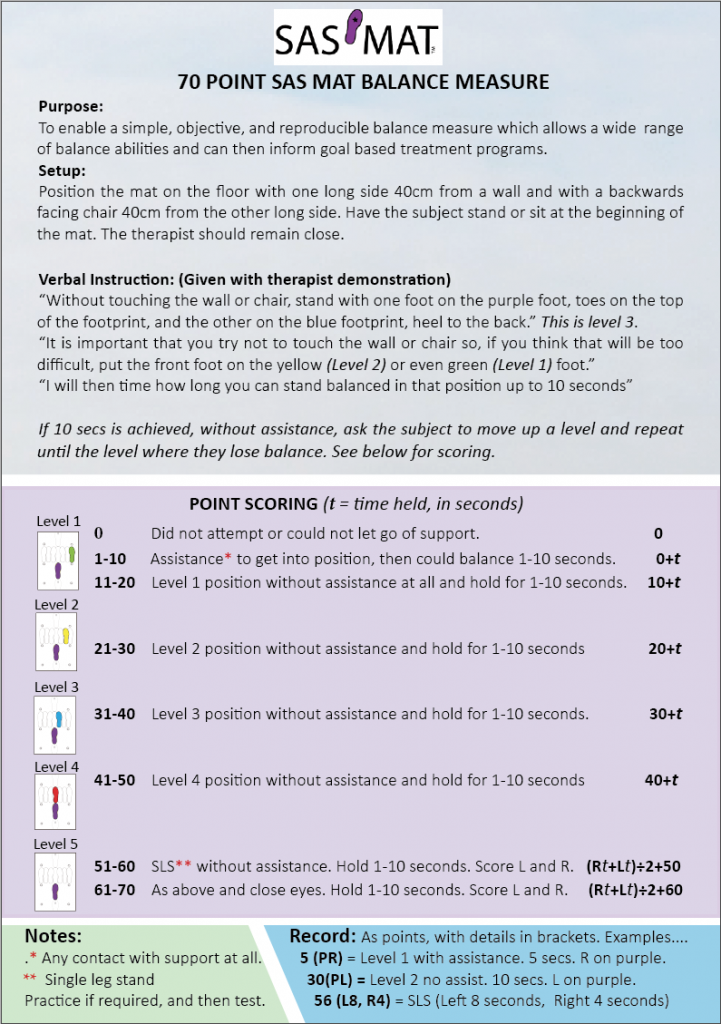Current Standing Balance Measures
Current balance assessment methods have many variables which are difficult to control for.
1) Achieving a reproducible foot position
2) Achieving Inter-rater reliability in technique and level of assistance provided.
3) Achieving functional significance, and .
4) Ensuring that a broad range of balance abilities are measurable.
Consider problems often encountered, for instance, when testing balance in Tandem standing (Heel to Toe Standing)
· Subject 1 can stand up and get into a tandem stand position without any assistance, first attempt and stand for 10 seconds. They score a 10.
· Subject 2 can get into position without support on the second or third attempt and then stand for 10 seconds unaided. They also score a 10.
· Subject 3 can get into tandem stand using assistance (a chair, wall, or physical assistance) and then let go and stand balanced for 10 seconds. They also score a 10!
All score 10. But clearly, they have different balance abilities.
To avoid this ‘ceiling’ effect, we then routinely ask the subject to complete a single leg stand (SLS) for 10 seconds. The subject can choose to stand on whichever leg they like.
Consider: Subject 1 can then stand easily on the right leg for 10 seconds. They will score a SLS of 10.
However, if they can only stand for 4 seconds on the left leg, this is often not scored, but will obviously affect functional balance.
Also, Subject 4, who comes in using a walker and cannot get into a tandem stand position, even with assistance, will score a 0. The ‘floor’ effect – it does not acknowledge any balance ability at all. This can be demoralizing for the client.
Some assessment measures record the details noting whether or not assistance was required and for how long a client could manage – others just have a binary approach – able or unable.
All of this leaves therapists with inconsistent and often poorly representative balance scores which do not necessarily enable goal orientated exercise plans nor any inter-rater reliability. Hence the value of a more specific scoring system. – such as the 70-POINT SAS MAT measure.
Reference:
Interpreting the Need for Initial Support to Perform Tandem Stance Tests of Balance
Elizabeth S. Hile, Jennifer S. Brach, Subashan Perera, David M. Wert, Jessie M. VanSwearingen, Stephanie A. Studenski
Physical Therapy, Volume 92, Issue 10, 1 October 2012, Pages 1316–1328, https://doi.org/10.2522/ptj.20110283

Recording
Record as Points with details in brackets.
The points score is a single numerical score from 0-70. It reflects the level at which the test was done and the time, in seconds, a client could balance unaided.
Details in brackets include either; which foot was on the purple foot, (PL) or (PR) or; for scores above 50, the time (t) spent standing balanced on each foot – measured in seconds and recorded as (Rt,Lt)
These details enable the test to be repeated as accurately as possible.
Notes:
Have one practice then test.
The time is stopped when the subject loses their balance either by contacting any support with their hands, or breaking the foot position, or requiring the therapist to intervene.
*If a subject requires assistance, either using the wall/chair or even full assistance from the therapist but can then stand in Level 1 position unaided – they can still get a score from 1-10 but do not progress.
Score Examples:
| Points Score | Explanation |
| 0 | Could not get into level 1 position even with assistance or would not attempt test. |
| 6(PL) | Required assistance to get into level one position but then could stand unaided for 6 seconds. Had Left foot on the purple foot. |
| 16(PL) | Could get into Level 1 position without any assistance and stand unaided for 6 seconds. Left foot on purple. |
| 28(PR) | Could get into level 2 position without any assistance and stand unaided for 8 seconds. Had the right foot on the purple foot. |
| 40(PR) | Could stand on the level 3 position for 10 seconds with the right foot on purple. Could not get into level 4 without assistance |
| 50(PR) | Could stand at level 4 position for 10 seconds but could not stand on either leg without assistance. Right foot on purple. |
| 51(R2, L0) | Could stand on the right leg unaided for 2 seconds but could not stand on the left at all. Score= (2+0)/2+50= 51 points. |
| 70: (R10,L10) | Could stand on each leg unaided for 10 seconds with eyes shut. Score= (10+10)/2 + 60 =70 points |
Considerations:
Time for 30 seconds to further differentiate abilities.
Advantages:
The proposed advantages of this system are:
- A broad range of balance abilities can be measured.
- A single numeric points score is useful for goal setting, for both the client and the therapist.
- The test is easy to administer, reliable and reproducible.
- The test has functional significance in determining intervention/s required and current abilities.
Copyright©2022 Stopfalls Physio. All rights reserved
